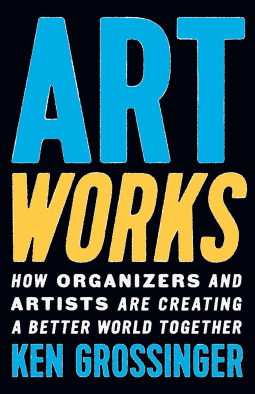
Art Works
How Organizers and Artists Are Creating a Better World Together
by Ken Grossinger
This title was previously available on NetGalley and is now archived.
Send NetGalley books directly to your Kindle or Kindle app
1
To read on a Kindle or Kindle app, please add kindle@netgalley.com as an approved email address to receive files in your Amazon account. Click here for step-by-step instructions.
2
Also find your Kindle email address within your Amazon account, and enter it here.
Pub Date Jul 18 2023 | Archive Date Jul 18 2023
Talking about this book? Use #ArtWorks #NetGalley. More hashtag tips!
Description
Named one of The Progressive magazine's Favorite Books of the Year
An inside look at the organizers and artists on the front lines of political mobilization and social change
“Ken [Grossinger] is one of the smartest strategists I know.” —John Sweeney, AFL-CIO president, 1995–2009
An artist’s mural of George Floyd becomes an emblem of a renewed movement for racial equality. A documentary film injects fuel into a popular mobilization to oust a Central American dictator. Freedom songs course through the American civil rights movement.
When artists and organizers combine forces, new forms of political mobilization follow—which shape lasting social change. And yet few people appreciate how much deliberate strategy often propels this vital social change work. Behind the scenes, artists, organizers, political activists, and philanthropists have worked together to hone powerful strategies for achieving the world we want and the world we need.
In Art Works, noted movement leader Ken Grossinger chronicles these efforts for the first time, distilling lessons and insights from grassroots leaders and luminaries such as Ai Weiwei, Courtland Cox, Jackson Browne, Shepard Fairey, Jane Fonda, Elizabeth Alexander, Bill McKibben, JR, Jose Antonio Vargas, and more. Drawing from historical and present-day examples—including Black Lives Matter, Standing Rock, the Hip Hop Caucus, the Legacy Museum, and the Art for Justice Fund—Grossinger offers a rich tapestry of tactics and successes that speak directly to the challenges and needs of today’s activists and of these political times.
Available Editions
| EDITION | Other Format |
| ISBN | 9781620976722 |
| PRICE | $26.99 (USD) |
| PAGES | 248 |
Available on NetGalley
Featured Reviews
 Ellen R, Reviewer
Ellen R, Reviewer
Ken Grossinger is a social and economic justice activist and Director of the Impact Philanthropy and Donor Advising division of Democracy Partners. For thirty-five years he has been working with unions, philanthropic and community organizations, encouraging collaboration as a means of social change. In Art Works, he discusses the ways that the arts have in the past affected social movements, lists dozens of contemporary social-cultural projects and posits that strategic collaboration between culture, social movements and philanthropy has great potential to boost the impact of social justice projects and to involve people from a variety of groups.
Grossinger starts with one of America’s most visible cultural-social examples, the involvement of musicians and community groups in the civil rights movement., arising from singing traditions in the Black church and moving through the popular folk-style music of Pete Seeger, Peter Paul & Mary and Joan Baez, to the public murals and social media activism of Black Lives Matter. Subsequent chapters detail cultural activism on behalf of the environment and immigration.
While reading these chapters, I was struck by the lack of arts organizations included. Most of the examples were of individual artists and musicians collaborating with commercial businesses and social nonprofits. I learned why when I reached chapter 5. This and the following chapter examine the role of traditional museums and philanthropic foundations in social movements, and makes a strong case for disrupting long held notions about how they operate. Museums are, for example, hampered by their need to schedule months and years in advance (making responding to current conditions difficult), their need to cater to the desires of donors and board members, and their need to maintain buildings and collections. Museums have also tended to emphasize events rather than long-term relationships, and have worked from the top down rather than bottom up. Grossinger lists several museums who have created advisory boards, reimagined public spaces, created long-term community relationships, and looked internally to issues from wage structures to challenging donor insistence on particular points of view. One of the examples of the latter include the prevalence of “art-washing,” in which donors attempt to use art as a way to improve public relations.
The only thing that bothered me with this book is the relative lack of examples of nonprofit music and theater organizations (film and commercial music are well represented), as are examples of local communities doing good work. The latter is understandable given the territory that would need to be explored, but it’s still worth noting that sometimes local organizations are more nimble than larger ones and can respond to current issues with fewer financial resources. I can think of several examples in my own hometown, including a mural of local community leaders of color, a public art exhibit about honeybees, and an exhibit of community-made Dio de Los Muertos altars, all of which helped steer the local conversation on issues of importance.
Grossinger conducted over one hundred interviews, and the book includes extensive notes, color plates, and indexing, all of which make it appropriate as a university-level textbook, but is written in a style that is accessible to community leaders from all sectors. I highly recommend it.
Many thanks to the New Press and NetGalley for the advance reader copy in exchange for my honest review.



